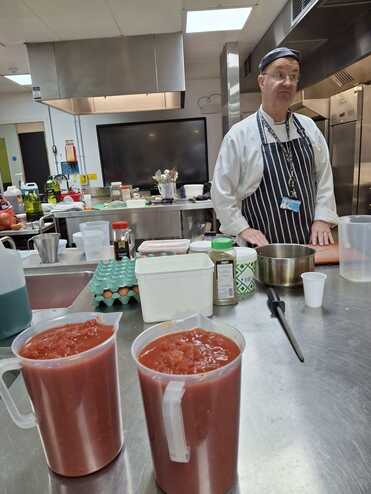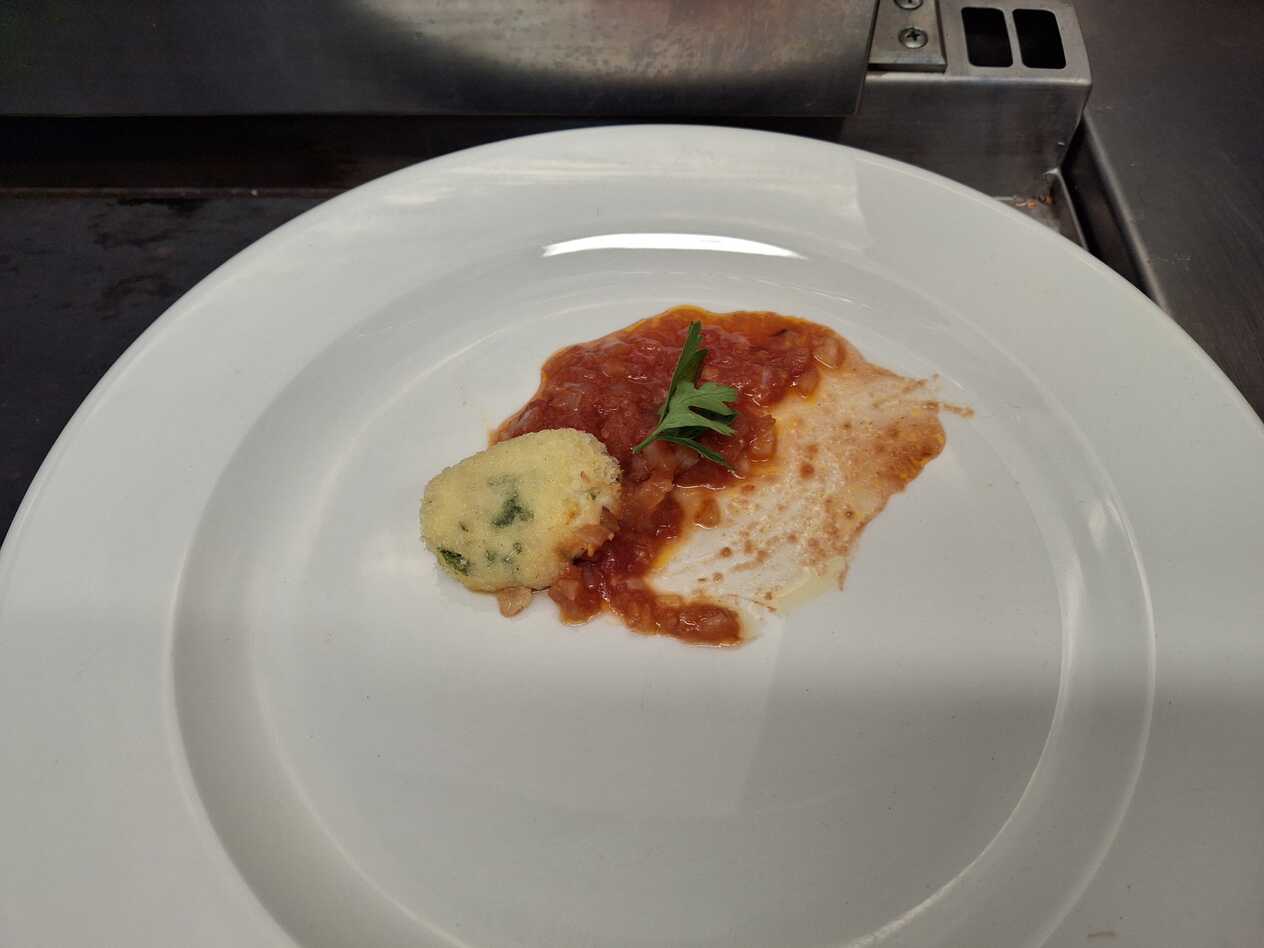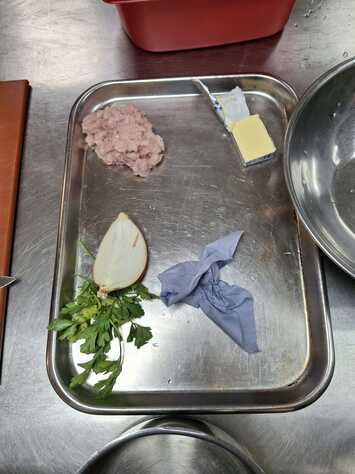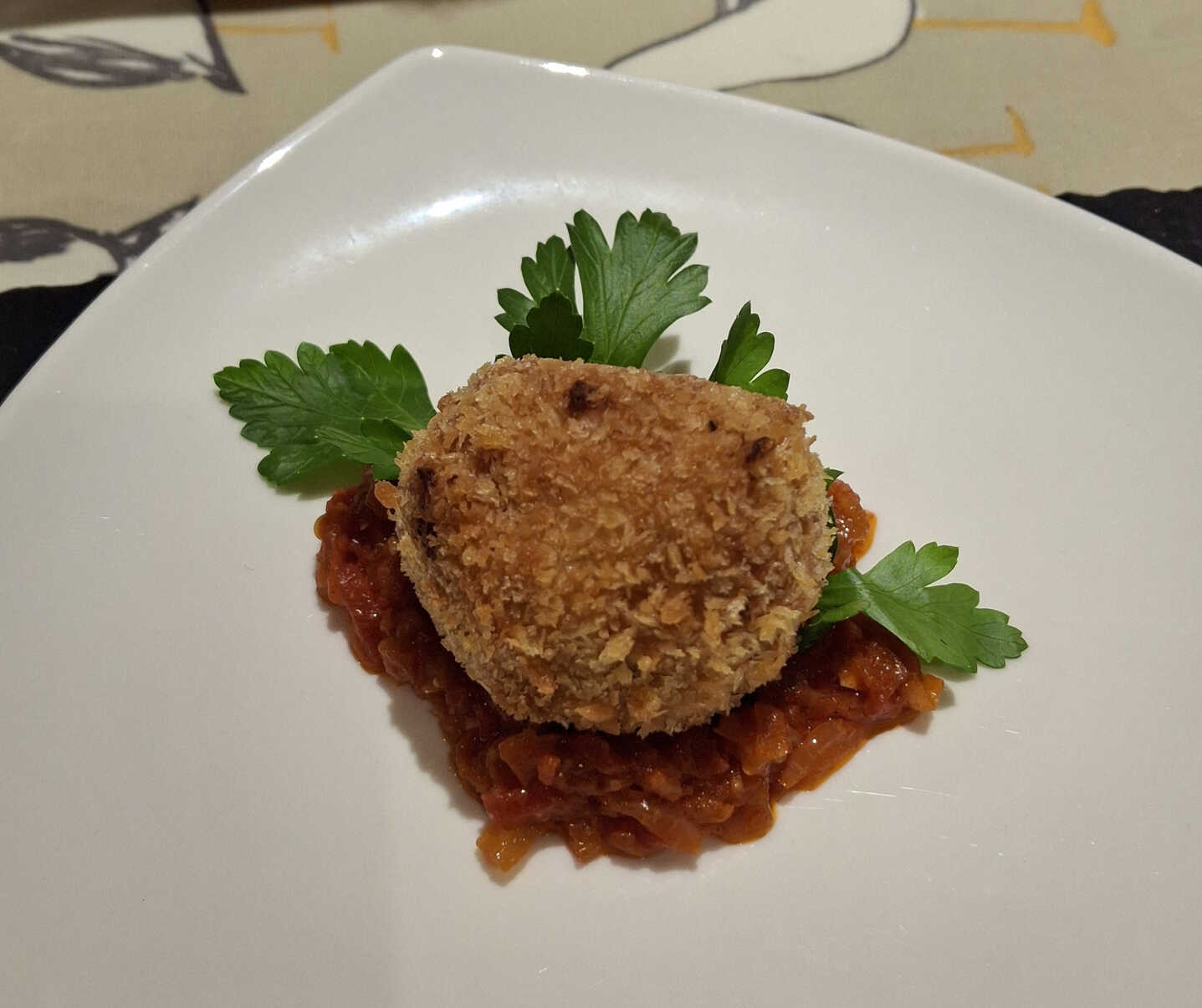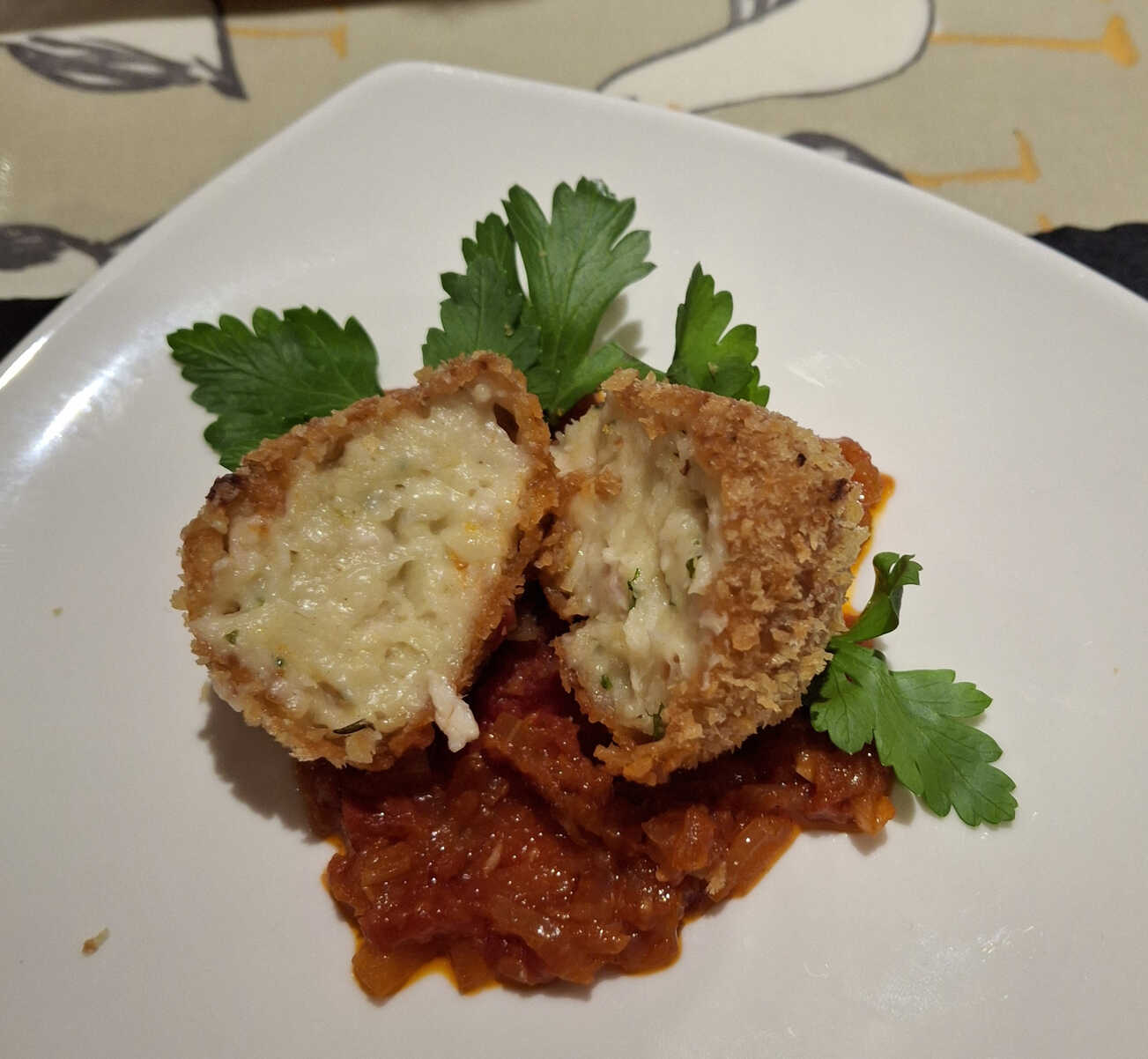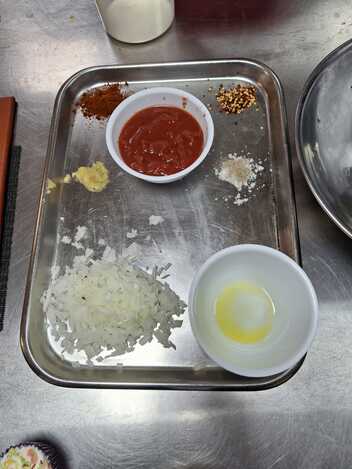
Street Food 3 - It's a Croque!
Finally we cook an actual street food Street Food: Croquettes.
These deep-fried gems of stuffed and pannéed panade are eaten in just about every country in the world.
Panné refers to the process of coating foods in breadcrumbs in order to protect them whilst deep-frying or baking, and giving them a nice crispy coat.
The word comes from the French past participle of bread, and literally means breaded.
Panade or Panada, on the other hand, is a starchy paste used as a binder or filler for ground meat or fish, or as a thickening agent.
When made with moistened bread it's often used in sausages to lubricate the meat and hold the filling together, though in proportions of more than ⅓ it's really just a bulking agent for swindling butchers.
It can also be made with rice, or potato, or flour in the form of a thick béchamel sauce as here.
Though arriving via Spanish, this word too has its roots in pãnis - the Latin word for bread.
Crocchette in Italy, kroketter in Sweden, aloo tikki in India, korokke in Japan, and крокетЫ in Russia are usually made with mashed potato.
Croquetas in South America and the Caribbean are often made with yam or cassava.
Italy's arancini and suppli are made of rice, as are some versions of Japan's korokke. Unsurprisingly 😉
Finally, Brazilian coxhinas, Nigerian chin chin, Greek κροκετες and of course, today's delicacy, Spanish Croquetas are made with floury béchamel.
In fact the only country in the world which doesn't make croquettes is France - the country which invented them!
Just joking. Of course they do!
The word croquette actually comes from the French for crunchy.
More, somewhat random, PaulPointers™:
These deep-fried gems of stuffed and pannéed panade are eaten in just about every country in the world.
Panné refers to the process of coating foods in breadcrumbs in order to protect them whilst deep-frying or baking, and giving them a nice crispy coat.
The word comes from the French past participle of bread, and literally means breaded.
Panade or Panada, on the other hand, is a starchy paste used as a binder or filler for ground meat or fish, or as a thickening agent.
When made with moistened bread it's often used in sausages to lubricate the meat and hold the filling together, though in proportions of more than ⅓ it's really just a bulking agent for swindling butchers.
It can also be made with rice, or potato, or flour in the form of a thick béchamel sauce as here.
Though arriving via Spanish, this word too has its roots in pãnis - the Latin word for bread.
Crocchette in Italy, kroketter in Sweden, aloo tikki in India, korokke in Japan, and крокетЫ in Russia are usually made with mashed potato.
Croquetas in South America and the Caribbean are often made with yam or cassava.
Italy's arancini and suppli are made of rice, as are some versions of Japan's korokke. Unsurprisingly 😉
Finally, Brazilian coxhinas, Nigerian chin chin, Greek κροκετες and of course, today's delicacy, Spanish Croquetas are made with floury béchamel.
In fact the only country in the world which doesn't make croquettes is France - the country which invented them!
Just joking. Of course they do!
The word croquette actually comes from the French for crunchy.
More, somewhat random, PaulPointers™:
- Paul disapproves of supermarkets.
- Paul disapproves of panko, and believes breadcrumbs should be freshly homemade.
- Paul recommends baking things (like salmon) caked in salt.
- Paul recommends serving breaded, fried poached eggs on our tomato sauce.
- Paul recommends substituting honey for all your sugary needs.
- Paul warns against wearing a dangly necklace whilst leaning over hot stoves.
- Béchamel sauce (or any acidic white sauce) can react with an aluminium pan turning grey or apparently even green!
- It's best to use heated milk when making the béchamel for a smoother sauce. Or beat it like hell. Or liquidise it.
- Watch out for the cooking béchamel sauce spitting boiling napalm into your face.
- Double or triple breadcrumbing is for cheap restaurateurs or for wrapping fillings which might leak.
menu
Croque On
Croquetas de Polo
Croquetas de Polo
Pannéed Panade made with Panache by Paul 😀
Salsa de Tomate
A basic tomato dipping sauce.
Croquetas de Pollo
Chicken Croquettes
Chicken Croquettes
fowl snack starter
Paul borrowed an actual recipe 😲 for this class - so we have quantities!
Many authentic-looking Spanish recipes for Croquetas de Pollo simmer the chicken separately (sometimes in milk), then use the stock to enhance the béchamel sauce, and add the bird's shredded, cubed or puréed flesh to the panade at the end.
The relative quantities of butter, flour and milk all seem somewhat arbitrary, but it's a good rule of thumb for making a roux to use the same volume of flour as butter.
Add only as much milk as required to bring the panade off the pan sides and into a thick paste which will mound up on the back of a spoon, and you can almost stand a spoon up in.
Fine regular or toasted breadcrumbs, rather than the ubiquitously trendy panko, are best for this dish. They give a more even powdery coating - panko are a bit too chunky here.
Many authentic-looking Spanish recipes for Croquetas de Pollo simmer the chicken separately (sometimes in milk), then use the stock to enhance the béchamel sauce, and add the bird's shredded, cubed or puréed flesh to the panade at the end.
The relative quantities of butter, flour and milk all seem somewhat arbitrary, but it's a good rule of thumb for making a roux to use the same volume of flour as butter.
Add only as much milk as required to bring the panade off the pan sides and into a thick paste which will mound up on the back of a spoon, and you can almost stand a spoon up in.
Fine regular or toasted breadcrumbs, rather than the ubiquitously trendy panko, are best for this dish. They give a more even powdery coating - panko are a bit too chunky here.
Makes probably Two Dozen
Ingredients
- 2 chicken breasts we only had one
- 1 medium onion, finely diced
- 1-2 cloves garlic
- 110g butter
- 125g plain flour
- 750ml milk
- dried herbs optional
- ground nutmeg optional
- handful parsley, chopped
For the Pané:- flour
- 50/50 beaten egg and milk
- fine breadcrumbs
Mince the onion, and chicken. Mince, crush or purée the garlic.
Sweat in the butter over a low heat without browning until the onions turn glassy and the chicken is cooked through.
Add dried herbs if you like. Some ground nutmeg seems like a popular addition.
Now over low heat add the milk a splash at a time, particularly to begin with, beating the mixture back together after each addition, and continuing to cook and thicken.
You want the result to be thick enough to hold its shape while cooking, so stop adding milk when the mixture binds into a smooth thick almost spongy paste, pulls away cleanly from the sides of the pan, and before it becomes sloppy or sticky to the touch.
When it is chilled and firmed up, cut or scrape it up into portions and roll them into balls, barrels, or whatever exotic shapes your heart desires.
Pané the croquettes by rolling them first in flour, then egg mix shaking off any excess, then in breadcrumbs. Set them aside.
Heat oil in a fryer to 180°C, gently drop in the croquettes and fry for about 10 minutes until golden brown. Remove with a slotted spoon and drain on kitchen roll.
Sweat in the butter over a low heat without browning until the onions turn glassy and the chicken is cooked through.
Add dried herbs if you like. Some ground nutmeg seems like a popular addition.
If you prefer you can cook and mince the chicken separately and add it back at the very end.
Set the milk to heat without boiling in a small pot.
Heating the milk will more easily produce a smooth béchamel sauce, without which you may find you need to beat the mixture like a demented stepfather, or use a blender.
Tip in the flour and continue cooking until the mixture coheres and begins to colour slightly.Now over low heat add the milk a splash at a time, particularly to begin with, beating the mixture back together after each addition, and continuing to cook and thicken.
You want the result to be thick enough to hold its shape while cooking, so stop adding milk when the mixture binds into a smooth thick almost spongy paste, pulls away cleanly from the sides of the pan, and before it becomes sloppy or sticky to the touch.
In which case you have now gone too far and will have to throw it out and start again.
Or you could use it as a very rich béchamel sauce, together with the marinara sauce below, in a delicious lasagne left as an exercise for the reader.
Or just cook in more flour 🤣
Season the mixture, mix in chopped parsley you can add grated cheese too at this stage, and spread it out on a tray to cool for an hour or two in the fridge.
Or you could use it as a very rich béchamel sauce, together with the marinara sauce below, in a delicious lasagne left as an exercise for the reader.
Or just cook in more flour 🤣
It will keep in the fridge for days at this stage.
Though you should probably then cover it with clingfilm to stop it skinning over.
Though you should probably then cover it with clingfilm to stop it skinning over.
When it is chilled and firmed up, cut or scrape it up into portions and roll them into balls, barrels, or whatever exotic shapes your heart desires.
Paul regales us with stories of lamb cutlet shaped croquettes ooop North.
I made mine the size of golf balls, but that's actually too large - the outside will burn in the deep fryer before they've properly heated all the way through.
About two bites-sized seems about right - perhaps plum sized?
You can make smooth balls by spinning the dough around in the inside of a cooking ring, or smooth barrel shapes by rolling them under a board or palette knife.
Set out three large bowls - one with flour, one with breadcrumbs to which you can also add grated hard cheese, and one with a 50/50 mix of milk and beaten egg.I made mine the size of golf balls, but that's actually too large - the outside will burn in the deep fryer before they've properly heated all the way through.
About two bites-sized seems about right - perhaps plum sized?
You can make smooth balls by spinning the dough around in the inside of a cooking ring, or smooth barrel shapes by rolling them under a board or palette knife.
Pané the croquettes by rolling them first in flour, then egg mix shaking off any excess, then in breadcrumbs. Set them aside.
If your panade mixture seems insufficiently firm, you can try running the croquettes back through the egg mix and breadcrumbs again to get a thicker shell for better frying protection.
You can chill or freeze them for later at this stage. Defrost before frying.
You can chill or freeze them for later at this stage. Defrost before frying.
Heat oil in a fryer to 180°C, gently drop in the croquettes and fry for about 10 minutes until golden brown. Remove with a slotted spoon and drain on kitchen roll.
I found that you could effective re-heat croquettes in an air fryer, but they didn't seem to do well for the first round of cooking - they collapse into puddles as the panade gets melty.
I imagine you might have the same problem shallow-frying or oven-baking them.
So best cooked in a deep fryer where the fat gives all-round support so they keep their shape, at least until their outsides crisp up.
Salt and serve immediately, or keep warm in a low oven.
I imagine you might have the same problem shallow-frying or oven-baking them.
So best cooked in a deep fryer where the fat gives all-round support so they keep their shape, at least until their outsides crisp up.
Quite delicious with a nice dipping sauce!
Tomato Sauce
sauce veg vegan
This is a basic, marinara-type, tomato sauce but rich enough to be used as a dip.
Paul suggests that this sauce is the ideal starting point for an infinity of exciting uses:
Paul suggests that this sauce is the ideal starting point for an infinity of exciting uses:
- Smeared on a pizza crust.
- As one of the layers in a lasagne.
- Thinned to make a rich tomato soup.
- As a curry base with the addition of Indian spices such as coriander, cumin, garam masala.
- As the liquid in a stew or tagine.
Makes about 2 Cups
Ingredients
- olive oil
- 1 onion, finely diced
- 2-3 cloves garlic, finely sliced or puréed
- salt & pepper
- chilli flakes
- smoked paprika
- couple of cups tinned tomatoes
- tablespoon of sugar Paul recommends honey
- herbs to finish
Heat a generous pool of olive oil until shimmering but not smoking.
Add dried chilli or chilli flakes.
Add finely diced onion and sweat until it softens and turns glassy without browning. Add the garlic and cook until fragrant.
Add smoked paprika and stir through, then the tinned tomatoes.
Cook the tomatoes down over a gentle heat. Add a little sugar or honey, or balsamic vinegar if you like. The sauce should thicken and darken.
Season, add chopped fresh herbs basil is particularly good, liquidise it if you like, and use for whatever ails you.
Add dried chilli or chilli flakes.
Add finely diced onion and sweat until it softens and turns glassy without browning. Add the garlic and cook until fragrant.
Add smoked paprika and stir through, then the tinned tomatoes.
Cook the tomatoes down over a gentle heat. Add a little sugar or honey, or balsamic vinegar if you like. The sauce should thicken and darken.
Season, add chopped fresh herbs basil is particularly good, liquidise it if you like, and use for whatever ails you.
Can't go wrong. Unless you burn the garlic!
